Southern Soundscapes
Ecological sound art responses to two South Australian ecosystems
An emerging ecological discipline, soundscape ecology has already had a significant impact on the methods by which ecosystems might be engaged, analyzed and understood. Considering sounds as proxies for ecological activities, whether of biological agents or abiotic environmental processes, the innovative field of research has introduced new approaches of non-invasive, long-term analysis (Pijanowski et al. 2011a; Farina 2014).
Analyzing soundscapes through acoustic parameters such as frequency, temporal relationships, amplitude, sonic interactions, and spatial diffusion and gradients, soundscape ecology provides an effective framework in which environmental (acoustic) data may be garnered for subsequent use in creative contexts. In the case of music and sound art, these data types can relate to pitch and timbre, temporal and rhythmic patterns and cycles, volume and dynamics, sound spatialization and performance layout, and texture and counterpoint. As such, a creative framework-in-development termed “ecotonality” has been proposed that is intended to connect soundscape ecology with musical and sound art practice in order to produce effective compositional responses to specific places, their ecosystems and soundscapes (Budel 2016).
The implementation of this creative framework is explored in two works responding to specific South Australian ecosystems. Long Island, responding to the eponymous island bisecting the Murray River at Murray Bridge, utilizes real-world legislative controls related to motorboat activity as a compositional device, comparing terrestrial and aquatic soundscapes as impacted by anthropogenic activities. By contrast, Farina responds to the 140-year history of a notable desert ghost town in far-north South Australia. Moving from initial European settlement and rapid multicultural population increase to gradual decline throughout the twentieth century (and recent surges in volunteer revitalization efforts), the work uses town surveying referents to inform the spatialized octophonic format, and historical and sociological research to inform the reconstructed soundscape response.
Soundscape ecology has enjoyed an international proliferation of literature and research since the 2009 symposium held by the US Regional Association of the International Association for Landscape Ecology (US-IALE), where the term was first proposed. 1[1. See, for example, Pijanowski 2011a, Pijanowski 2011b and Farina 2014.] Led by landscape ecologists Bryan C. Pijanowski, Stuart Gage and Almo Farina, and field recordist Bernie Krause, the discipline focusses on the relationship between landscape and soundscape, or topographic and acoustic patterns:
Soundscape ecology represents a new transdisciplinary field of research strictly connected to landscape ecology… [investigating] the patterns and processes created by sounds at all levels of biological and ecological complexity. (Farina 2014, 5)
Drawing on research in the areas of spatial (or landscape) ecology, psychoacoustics, bioacoustics and acoustic ecology, the discipline takes an interdisciplinary approach, representing perspectives from ecology, psychology, ethology and the humanities, respectively. This broad multidisciplinary knowledge helps researchers in soundscape ecology to form a coherent and comprehensive understanding of a soundscape, its component parts, and its underlying ecological processes and relationships.
Taxonomically, soundscape ecology organizes itself around a sound source model, correlating acoustic phenomena with the entity producing the sound. Categories include:
- Biophony. The collection of sounds produced by all organisms at a location over a specified time.
- Geophony. Sounds originating from the geophysical environment, such as wind, water, thunder, movement of earth, etc.
- Anthropophony (also technophony). Human-produced sounds, created by stationary and moving human-made objects (Krause 2002; Krause 2015).
Additionally, numerous acoustic parameters provided the basis for soundscape analysis. These include:
- Frequency patterns;
- Temporal patterns at micro- (diurnal), meso- (seasonal) and macro- (climatic) cyclical levels;
- Amplitudinal patterns (loudness);
- Spatial dimensions (diffusion patterns);
- Gradients (abiotic processes impacting ecosystem activity);
- Interactions (the interrelations of biophony, geophony and anthropophony) [Farina 2014].
Methodologically, soundscape ecology is rooted in the methods of landscape ecology, which directly employ or appropriate field techniques and methods from ecology and naturalist studies, in addition to those of its other associated disciplines. As Farina writes, the discipline uses a “broad range of field and laboratory approaches from bioacoustics to psychoacoustics and truly heterogenous methods to collect, process, and interpret sonic data” (Farina 2014, 221).
Multiple tools are consequently employed, including spatial analysis tools (geographic information systems, remote sensing technology and spatial metric software), high fidelity and portable digital sound recording equipment, automated remote recording technologies, and audio software and databases (enabling precise analysis, manipulation and rendering of sound samples, correlation of these with spatial interfaces and databases, and calculation of metrics). There are a number of challenges that remain, including storage of large data quantities, equipment maintenance on remote recording networks, and, until recently, equipment costs, which are now rapidly diminishing (Krause 2002; Monacchi 2011).
Additionally, sound can be measured in a number of ways, and in soundscape ecology the main goal is “to process data to extract the emerging patterns in terms of complexity/information of the sonic environment” (Farina 2014, 239). The spectrogramme, capable of mapping frequency, time and amplitude, is most commonly used in this regard; other emerging tools related to other parameters such as geographic and topological mapping, and sound source identification, are increasingly used. Additionally, metrics have been developed for the evaluation and comparison of different recordings and soundscapes, in terms of their noise and exposure levels, as well as entropy, richness, dissimilarity, complexity and evenness indices (Ibid., 239–247).
Creative Framework — “Ecotonality”
With the establishment and development of soundscape ecology come many opportunities for creative application, especially as related to the field of ecological sound art (Gilmurray 2017). The following creative framework, under the working term of “ecotonality” 2[2. This term draws on the landscape ecology term “ecotone”, defined as the transition area between two biomes, where communities meet and interact, as much as it does the prefix “eco-” and musical term “tonality”.], has been documented in greater detail (Budel 2016), but is provided here in synopsis for context of the ensuing creative works. The creative process has six identified stages: conception, collation, preparation, composition, realization and reflection.
Conception
Prior to engaging with place, the work is conceived. This may be divided into three sub-stages:
- Research: engaging with multiple perspectives — ecological, historical, sociocultural and spiritual — of places through primary and secondary sources;
- Sketching: initial brainstorming of creative responses;
- Planning: logistical and material preparation for engagement with place.
Collation
Following conception, the collation of creative materials occurs. Focussed around involving field work, collecting resources (materials, information and ideas) for the composition, activities may include sound walks, observation and documentation, field recordings and consultation.
Preparation
Following the collation stage, the materials are analyzed and transformed in preparation for the composition stage. The quantitative and qualitative analyses aim to extract information about the content and context of each resource. This informs the transformative techniques, which may include (but are not limited to) transcription and data sonification for acoustic instrumentation, and sample manipulation or editing, sonification and eco-structural treatments of data for electronics. Novel transformational processes may be developed through adaptation of various environmental dynamics related to the specific place.
In considering the means to exchange materials from an objective “soundscape ecology” perspective to a subjective “creative” approach, the soundscape ecology analysis parameters of frequency, temporality, amplitude, spatiality and interactivity may be correlated with the musical elements of pitch/timbre, duration/structure, loudness, spatial location and texture (Burton 2015), respectively. This basic system establishes associative relationships between soundscape and musical resources, providing a means of identifying a recorded sound or data structure’s properties and connecting them with potential musical treatments.
Composition
The assemblage of the transformed materials then takes place, according to the initial sketches and plans, and new insights from observed ecological processes and relationships (which engender context for the content of the soundscape).
Realization
Once composition is completed, the work is ready for realization. Preparation and execution of this stage occur with respect to the media employed. For works for acoustic media, the traditional method of delivery to materials to performers, rehearsal(s) and performance(s) remains unchanged, as does the installation, auditioning and presentation of electronic works. These considerations combine in the case of works that make use of both types of media.
Reflection
The final step of the process is reflection, where evaluation of the process and outcome of the work can determine strengths and weaknesses of the approach and the reception of the final product by an audience. These insights can then inform the way one might approach future compositions.
Long Island
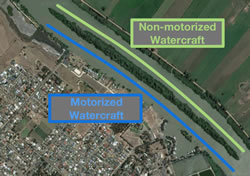
Long Island is a 1.8 km long island bisecting the Murray River at Murray Bridge. A significant part of Ngarrindjeri (local First Nation) culture, it represents the spear (“lenteilin”) thrown by ancestral elder Ngurunderi at Pondi (the cod) as their chase created the river. In more recent times, the Rural City of Murray Bridge Council has placed legislative restrictions controls around waterway navigation. Whereas the western side is open to motorized watercraft, the eastern side prohibits the use of such craft, in order to ensure the preservation of a waterfowl refuge (Fig. 1).
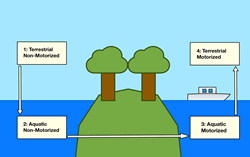
Contemporary scientific research of aquatic soundscapes is finding increasing evidence that human motorized boating activities are making significant negative impact on aquatic species. The use of such machinery often creates noise that occupies a broadband frequency range and sounds at very loud volumes. By contrast, many of the life forms living in rivers and oceans have evolved to communicate and hear in narrowband frequency ranges and can only call at volumes relative to their physiology. As such, these animals find it increasingly difficult to communicate effectively because their signals are masked by watercraft noise and because they may have even sustained hearing damage from being subjected to such loudness (Peng, Xinguo and Guangxu 2015). Considering the impact of motorboat noise on terrestrial and aquatic environments in a creative context, I looked to heighten audience sensitivity to non-terrestrial soundscapes and to encourage them to consider less impactful alternatives to engagement with and enjoyment of these environments.
Formally, a space-by-space listening experience would progress, with the listener beginning in the non-impacted soundscapes, first above water (Terrestrial Non-Motorized) before submerging below (Aquatic Non-Motorized). While still immersed, boat activity is gradually introduced and becomes overwhelming, after which the listener emerges to the open air, with the sounds of the boats continuing (Fig. 2).
Creative Development
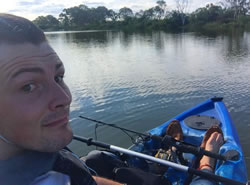
Initially, my research involved gathering surveying records of the island from local government, consultation with the local Historical Society and long-time neighbours (pertaining to European colonial and current use of the space), and analysis of data provided by the Department of Environment, Water and Natural Resources. Following this, I made multiple recording trips with a portable recorder around and on the island between April 2016 and April 2017. Recording above water took place both on the island’s eastern side and on the jetty adjacent to the western channel’s boat ramp, capturing both the non-motorized and motorized terrestrial soundscape material respectively. Recordings below water involved the suspension of two Aquarian Audio H1-A hydrophones from above the water: on the non-motorized side, this was done from the kayak in the middle of the river (Fig. 3); on the motorized side, from the aforementioned jetty.
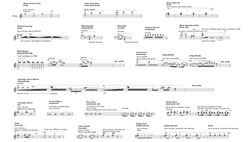
Preparing these materials for composition, I decided on an electroacoustic setup. This would feature a stereophonic soundscape composition comprised of field recordings and Foley samples of motorboat activity, and string and piano instrumental activity playing transcriptions of assorted animal calls and spectrally filtered harmonic structures. I began by assembling the fixed-media component, organizing the field recordings according to the conceptual formal plans. Filtering and convolution reverb were used to reinforce the acoustic characteristics of each medium, air or water. Then, considering the instrumentation, I recycled string transcriptions of numerous avian species’ vocalizations from a previous project focussed on a nearby location, Mobilong (Budel 2016). These transcriptions were made by identifying local species via signage at a nearby bird hide, analyzing the spectral content of call samples recorded there using SPEAR (Collins 2010, 84), ascertaining their pitch and timbral qualities, and then notating this information for flexible string ensemble performance (Fig. 4). This is an example of what Truax calls “phonography” (2008), or the mimetic representation of environmental sound or soundscapes through either acoustic or electronic means, achieved with minimal editing or abstraction.
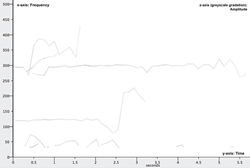
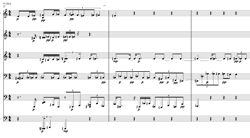

The piano part was devised through multiple stage analysis and transformation. Following the development of the soundscape composition, each formal habitat’s content was divided up into 15-second samples and underwent spectral analysis. Partial filtering (between 30 Hz to 4200 Hz to reduce information to the keyboard range) and amplitude filtering (a minimum of -45 dB for terrestrial, -35 dB for aquatic soundscape) revealed the most prominent pitch material (Fig. 5). This was then rendered as MIDI data in the MaxScore Environment, Macaque (Didkovsky and Hajdu 2008), as seen in Fig. 6. This MIDI data was then imported into music notation software and edited into a performable score format. After rounding pitched sounds (which had been rendered as quarter tones by the notation software) to the nearest semitone, the material was arranged for piano, with considerations of phrasing — partial trajectories were interpreted as contrapuntal lines — and fingering (Fig. 7).
With obvious challenges in conveying non-human experience to a human audience, I opted to use æsthetic displeasure as a mediating communicative tool, positioning the ambient soundscape against introduced anthropogenic noise. By keeping the “non-motorized” soundscape field recordings and instrumental dynamics at a relatively low amplitude throughout the work (akin to real-world circumstances), the intervention of loud motorboat activity in the work’s second half creates a stark contrast by masking the ambient acoustic activity.
Though this may seem to apotheosize the natural over the human-made, reinforcing the Romantic divide between humanity and the environment, I felt it necessary to frame this ecological issue such that the relationships between agencies and entities in the ecosystem were easily perceivable by a general audience. In the absence of a programme note — a prescriptive device to tell the audience how and why to listen — the contrast in the soundscape’s biophony / geophony and anthropophony, and its general relationship to the listener’s lived experiences, intend to convey something of the non-human acoustic experience or ecotonality of the environment surrounding Long Island.
Farina
Farina is a ghost town in the arid lands of Far North South Australia. It was founded in 1876 as an agricultural community in spite of advice from Surveyor General George Goyder. The famous “Goyder Line” denoted areas of reliable rainfall in the then colony; Farina lies far outside of this boundary (Sheldrick 2013). Following multiple seasons of crop failure, the town became a service centre for the central region of the country in the early to mid-20th century, the population gradually declining in tandem with the arrival of telecommunications and motorized transportation. So too was there a significant multicultural presence, particularly of Adnyamathanha (local First Nations) peoples, Middle Eastern cameleers and Chinese workers. After its desertion in the mid-1960s, the town came under the custodianship of Farina Station, a large area of pastoral lease land encompassing the ruins (Fig. 8). In recent years, there has been significant restoration activity by the Farina Restoration Group, preserving Farina as a historic desert pioneer town (Olston 2009).
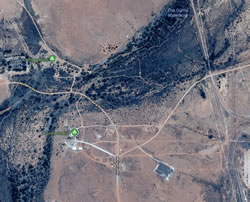
In terms of infrastructural considerations, the town’s surveying design, like many early South Australian towns, was based on that of the state capital, Adelaide, with border terraces in each cardinal direction, divided by a gridded street system (Fig. 9). To the west of the town, a train line ran north and south, constituting a hub of activity throughout the town’s history, as well as the site of many technological changes (train engines, alterations in railroad infrastructure and, later, the introduction of cars and planes). Many businesses and dwellings were situated in the town vicinity, with many industries represented: ruins still visible today include hotels, an underground bakery, blacksmiths, police stations, general stores, stables and churches. Surrounding the town were numerous multicultural presences. For example, an Adnyamathanha camp was located to the north ahead of Station Creek, gardens were established by Chinese railway workers closer to town and the Middle Eastern cameleer camp developed further to the west on Afghan Hill.
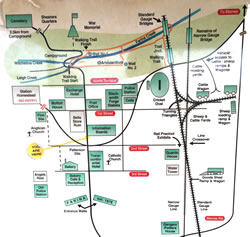
Considering the acoustic phenomena according to soundscape ecology’s categorizations, there are numerous sound sources to draw on. The historical geophony of the town, occupying a significant omnidirectional presence, is sounded through diverse fluctuations between drought and flood, and conveyed more subtly through the dry reverberance of the open, flat landscape. The biophony has multiple sources. Initially, native animals were the primary contributors, with introduced species later adding their calls. Similarly, human vocal presence was provided by Adnyamathanha community activities and ceremonies, with later additions coming about through European colonial settlement and the Islamic call to prayer from the mosque at Afghan Hill. The anthropophony exists at multiple levels of the microscale — sound related to specific industries such as hotels, bakery, blacksmith, etc., as well as infrastructure development — and the macroscale — primarily transportation and the changes of transit technologies on the ground and in the air.
In synthesizing this information, the idea eventually emerged to creatively reconstruct the soundscape, mapping the town’s acoustic evolution through its 140-year history from settlement to the modern day (Fig. 10). This would contribute to the growing body of research and work in “paleoacoustics” (the study of historic and ancient acoustic environments) as well as reconnect contemporary custodians, descendants and visitors with the landscape and soundscape of the town and greater Far North South Australia.
Creative Development
For my initial research, a number of print sources were consulted. Rob Olston’s Farina — From Gibbers to Ghost Town (2009) provides a comprehensive historical overview of the town’s development and was gleaned for references to industrial, technological and cultural dynamics that would have contributed to the evolving soundscape. A subscription to the Farina Restoration Group’s newsletter provided up-to-date information about the redevelopment activities and informed my understanding of the contemporary soundscape, and further historical artefacts — such as digitized copies of the town’s plan from the South Australian Archives — were gathered through in-group correspondence. Additionally, resources from the Department of Environment, Water and Natural Resources and from the Bureau of Meteorology were consulted for environmental and climatological information.

Beginning my collation of materials, I undertook a field trip to Farina in June 2016, during the South Australian winter. This involved recording with a portable recorder in various habitats, including gibber plains, scrubland and the creek. Additionally, I was able to engage with many locals, both permanent and transitory, whose specific knowledge of environment, industry and culture in the area informed my own understanding of place. Among them were Farina Station owners Kevin and Anne Dawes, head baker and president of the Farina Restoration Society Martin McLennan, and many other grey nomads 3[3. Slang term used (non-disparagingly) in Australia to refer to retirees travelling in RVs.] from around Australia. I also had the opportunity to participate in an annual commemorative ceremony conducted by representatives of the Royal Australian Air Force, acknowledging the death of Farina-born Flight Lieutenant John Bell, one of the first Australians killed in World War II.
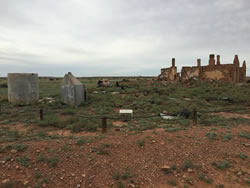
At the time of writing, the piece is still in development. However, the work to date is sufficient enough to document the ways in which the framework has been implemented for the project.
The first stage in assembling the work involved devising a schema for the temporal contraction of the 140-year period to a concert-work duration. Originally, each year (1876–2016) was attributed ten seconds; later, additional sets of 20 seconds at the beginning and end, to incorporate sound prior to European colonization and to extend the representation to the present day. This brought the work to a total 24-minute duration. The fixed media component was designed for performance over an octophonic speaker array, correlated with the cardinal and intercardinal directions of the town’s design. This permits a representation of Farina’s spatial dynamics, particularly that of the creek’s water flow in the north (flowing NE to NW), the transport thoroughfares to the east (flowing interchangeably between NE to SE) and the omnidirectionality of weather patterns (Fig. 12).
Following the organization of larger scale materials (e.g., weather activity), a collation of more specific sounds took place. As most historically based sounds in the work come from technologies no longer easily accessible (i.e. older models of cars, steam engines and planes), public-domain Foley recordings from online sound archives were sought and positioned in the tracks according to their years of usage and location in the town’s activities.
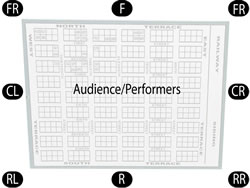
With an interest in including as many members of the Farina and wider South Australian communities as possible, a flexible percussion instrumentation was decided upon. This would permit both learning and (re)connection through active participation of the audience as performers, rather than passive observation. To achieve this, found objects were identified as accessible percussion instruments, including gibbers (flat desert rocks), corrugated iron, brick and stone, wood, tools and glass bottles. Many of these materials have associations with different social activities and industries, and are located in situ as a result of the town’s developments. Text scores were employed as a means of communicating ideas, providing simple instructions of how and when to play the found objects, in relation to the sociocultural, spiritual, industrial and infrastructural activities of the town. Additionally, two notated lead percussion parts for trained performers allow for more complex instrumentation and temporally specific gestures within the work’s performance. These performers would lead a series of community workshops for training prior to the performance.
There is also capacity for involvement of First Nations and multicultural communities, allowing for representation of and reconnection with associated cultural histories. While it is far easier to gain permission from elders and representatives of faith to integrate existing recordings into the electronic component of the work, I feel that this approach is tokenistic and has ethically unsavoury links to the colonialist mishandling of sensitive materials by Australian art music composers (Paget 2013). In wanting to actively involve current-day custodians, descendants and adherents of faith, my intention is to engage with these parties as collaborators, contributing what is felt relevant and meaningful to the sonic outcome of the piece.
A performance of the work is forthcoming, either coinciding with the Farina Restoration Group’s 2018 Winter activities or as an offsite presentation.
Reflection
In both Long Island and Farina, there are distinct outcomes beyond the environmental and ecological concerns that emerge from the compositional product. Though rooted in soundscape ecology perspectives and methods, each of these outcomes has a broader intention to convey, and communicates the historical, social, cultural and spiritual perspectives that are intimately interwoven in the ecosystems’ and soundscapes’ current circumstance. In addition to the site-specific nature of the island and the contrast between soundscapes to each side, Long Island also reveals, for example, perspectives of the non-human in general aquatic environments. Deliberately provocative in its juxtaposition of ambient soundscape and anthropogenic noise, the work obliges the audience to consider the experiential impact of human activities on aquatic organisms, thereby prospectively beginning movement towards behavioural and social change. In a different way, Farina provides a compressed overview of ecological and technological changes in the arid lands of Far North South Australia, at the same time engaging the contemporary community in active, first-hand participation. By removing the boundary between audience and performer and allowing people to communally engage in sound-making with similar materials as those used by forebears, historical reflection, social developments and cultural contributions all arise as interdependent perspectives. Ideally, this engenders sensitivity and appreciation of the ghost town’s sonic and sociocultural histories, and continues the narrative of its soundscape and acoustic ecology.
Future Directions
While still a relatively new and evolving field, soundscape ecology already offers new avenues for creative investigation. There exist many specific areas of investigation, but a number of central themes emerge.
Concepts
Soundscape ecology’s conceptual frameworks provide not only new perspectives for ecological analysis of acoustic environments, but also departures for creative response to environment. Bioacoustics hypotheses such as the acoustic niche hypothesis and the acoustic adaptation hypothesis may be utilized to demonstrate sonic structures and dynamics in biophonies, as David Monacchi has done in the context of his Fragments of Extinction project. Consideration of more tangible phenomena such as landscape, community and population dynamics can additionally provide the basis for compositional processes. And perhaps most potently, the creative possibilities of non-human cognitive and behavioural factors provide myriad directions of representational and communicational strategies between non-humans and humans, as per the work of David Rothenberg.
Technologies
Technological developments emerging in response to the advent of soundscape ecology will also spur on future creative pathways. The affordability and portability of recorders and microphones makes it increasingly easy for recordists to work in spaces that were previously difficult to access, notably through the use of remote recording networks, which make obsolete the need for continuous on-site supervision. Integration of these technologies with geographical information systems (GIS) provides an additional spatial parameter for creative consideration. Recording and diffusion with new sound technologies, such as binaural systems, ambisonics and wave field synthesis, have also emerged as prominent formats for creative practice in ecological sound art.
Big data sciences also hold many opportunities for creative practice. Batch analysis of sound databases (often vast libraries of soundscape recordings) can be used to automatically identify the temporality and physical location of disparate samples of similar soundscape phenomena (i.e. vocalizations, anthropogenic noise), permitting cross-sectional analysis and representation of soundscapes at different resolutions. Similarly, these analyses can generate metrics associated with various global indices (acoustic niches, acoustic diversity, gradient impacts) that are suitable for sonification, effects automation and other quantity-driven approaches. (Near) real-time analysis and processing of soundscape data can also be used in installation works or as input for the creation of generative notation for a live performer.
Strategies
Mediating these concepts and technologies are strategies that inform the ways in which ecologically minded composers and sound artists may employ their work in larger social and environmental contexts. Most prominent are the communicational strategies, utilizing art projects as means to present scientific knowledge to wider audiences. This often involves interdisciplinary collaboration between soundscape ecologists and composers / sound artists. Examples include Biosphere Soundscapes founded by Leah Barclay in 2012, David Monacchi’s Fragments of Extinction, the EcoSono collective founded and directed by Matthew Burtner (Gilmurray 2013) and David Dunn’s work in bioacoustics.
Socio-political strategies will increasingly become prominent, lending themselves to community empowerment. Here, soundscape ecology concepts and methods are used to motivate social and political change, in recognition of the numerous dynamics that relate to the soundscape, including power relations and oppression, identity and history, and community health. Leah Barclay’s documentary film Sonic Ecologies (2013) places emphasis on engagement and collaboration with local communities in the creative process.
Lastly, æsthetic strategies will also continue to be employed, whereby soundscape ecology concepts and methods will be used to facilitate greater appreciation of acoustic phenomena and behaviours in the soundscape (a key modus operandi of acoustic ecology). Notable projects include field recordist Bernie Krause and composer Richard Blackford’s The Great Animal Orchestra, which positions orchestral music and transcriptions against field recordings (Krause and Blackford 2014), and Garth Paine’s EcoRift (2015), providing a virtual reality experience of the Sonoran deserts’ soundscapes. A forthcoming work of my own, Featherstone Place, utilizes an urban sound installation and live performance to create renewed affective relationships between city dwellers and the urban soundscape.
Bibliography
Barclay, Leah. “Biosphere Soundscapes.” Leonardo 47/5 (October 2014) “Art-Science Is a Conceptual Blend,” pp. 496–497.
_____. “Sonic Ecologies: Exploring the agency of soundscapes in ecological crisis.” Soundscape: The Journal for Acoustic Ecology 12/1 (Winter/Spring 2012–13) “The Global Composition,” pp. 29–32. Available online at https://www.wfae.net/uploads/5/9/8/4/59849633/soundscape_volume12.pdf
Budel, Jesse. “Creative Responses to Soundscape Ecology: Innovative frameworks and case study.” ACMA 2016: Sonic Environments. Proceedings of the 2016 Australasian Computer Music Conference (Brisbane, Australia: Queensland Conservatorium, 10–11 July 2009). Available online at http://www.sonicenvironments.org/uploads/2/0/1/3/2013969/03budel_acmc2016.pdf
Burton, Russell. “The Elements of Music: What are they, and who cares?” In ASME XX — Music: Educating for life. Proceedings of the 20th national conference of the Australian Society for Music Education (Adelaide, Australia: 30 September – 2 October 2015). Edited by Jennifer Rosevear and Susan Harding.
Collins, Nick. Introduction to Computer Music. Chichester, UK: John Wiley & Sons, 2010.
Didkovsky, Nick and Georg Hajdu. “MaxScore: Music Notation in Max/MSP.” ICMC 2008: “Roots/Routes”. Proceedings of the 34th International Computer Music Conference (Belfast, Northern Ireland: SARC — Sonic Arts Research Centre, Queen’s University Belfast, 24–29 August 2008). Available online at http://www.georghajdu.de/gh/fileadmin/material/articles/cr1303.pdf
Farina, Almo. Soundscape Ecology: Principles, patterns, methods and applications. Science+Business. Dordrecht: Springer, 2014.
Gilmurray, Jonathan. “Ecoacoustics: Ecology and environmentalism in contemporary music and sound art.” 2013.
_____. “Ecological Sound Art: Steps towards a new field.” Organised Sound 22/1 (April 2017) “Context-Based Composition,” pp. 32–41.
Krause, Bernie. Voices of the Wild: Animal songs, human din and the call to save a natural soundscape. New Haven CT: Yale University Press, 2015.
_____. Wild Soundscapes: Discovering the voices of the natural world. Berkeley CA: Wilderness Press, 2002.
Krause, Bernie and Richard Blackford. “The Great Animal Orchestra: Symphony for orchestra and wild soundscapes.” http://thegreatanimalorchestrasymphony.com
Monacchi, David. “Recording and Representation in Eco-Acoustic Composition.” In Soundscape in the Arts. Edited by Jøran Rudi. Oslo: NOTAM, 2011, pp. 227–250.
Monacchi, David, Ulmar Grafe, Almo Farina and Anthony Di Furia. “Fragments of Extinction: A New recording approach in primary equatorial forests.” Proceedings of the 2014 Ecology and Acoustics meeting: Emergent properties from community to landscape (Paris, France: 16–18 June 2014). http://ecoacoustics.sciencesconf.org
Olston, Rob. Farina: From gibbers to ghost town. New Expanded Edition. Bundinyabba Publications, 2009.
Paget, Jonathan. “Has Sculthorpe Misappropriated Indigenous Melodies?” Musicology Australia 35/1 (2013), pp. 86–111.
Paine, Garth. The Listen(n) Project: Listening to the Earth. http://www.ecolisten.org/blog/about
Peng, Chao, Zhao Xinguo and Liu Guangxu. “Noise in the Sea and Its Impacts on Marine Organisms.” International Journal of Environmental Research and Public Health 12/10 (October 2015), pp. 12304–12323.
Pijanowski, Bryan, Almo Farina, Stuart Gage, Sarah Dumyahn and Bernie Krause. “What Is Soundscape Ecology? An introduction and overview of an emerging new science.” Landscape Ecology 26/9 (November 2011), pp. 1213–1232.
Pijanowski, Bryan, Luis Villanueva-Rivera, Sarah Dumyahn, Almo Farina, Bernie Krause, Brian Napoletano, Stuart Gage and Nadio Pieretti. “Soundscape Ecology: The science of sound in the landscape.” BioScience 61/3 (March 2011), pp. 203–216.
Sheldrick, Janis M. Nature’s Line. George Goyder: Surveyor, environmentalist, visionary. Adelaide: Wakefield Press, 2013.
Truax, Barry. “Soundscape Composition as Global Music: Electroacoustic Music as Soundscape.” Organised Sound 13/2 (August 2008) “Global Local,” pp. 103–109.
Social top